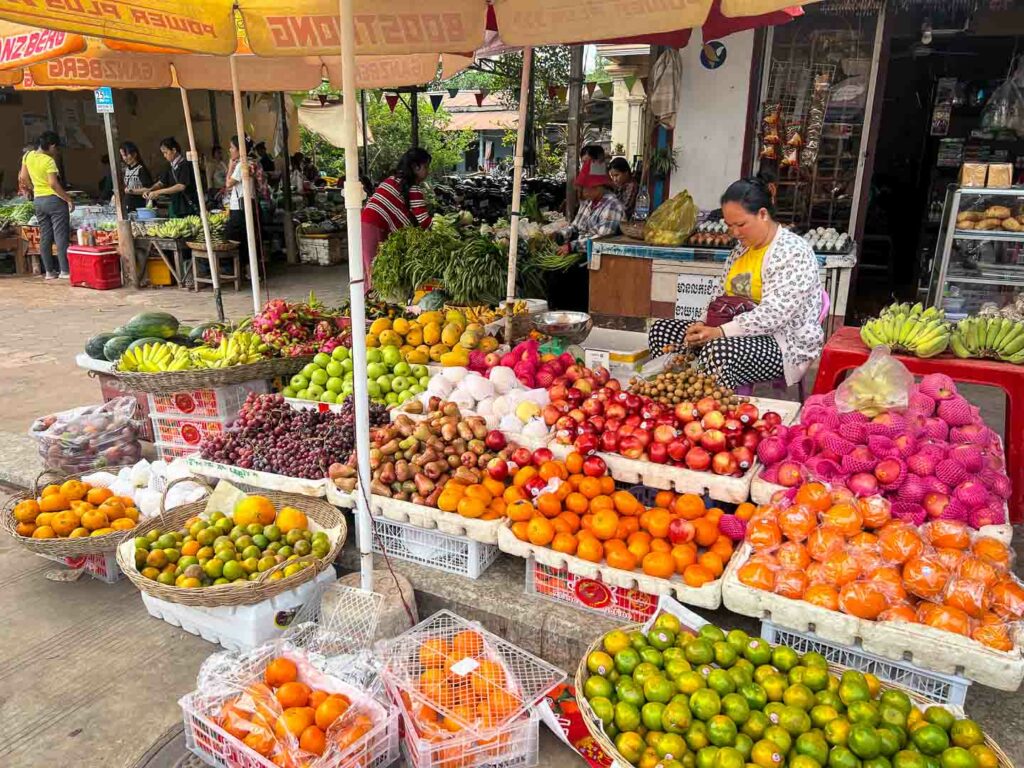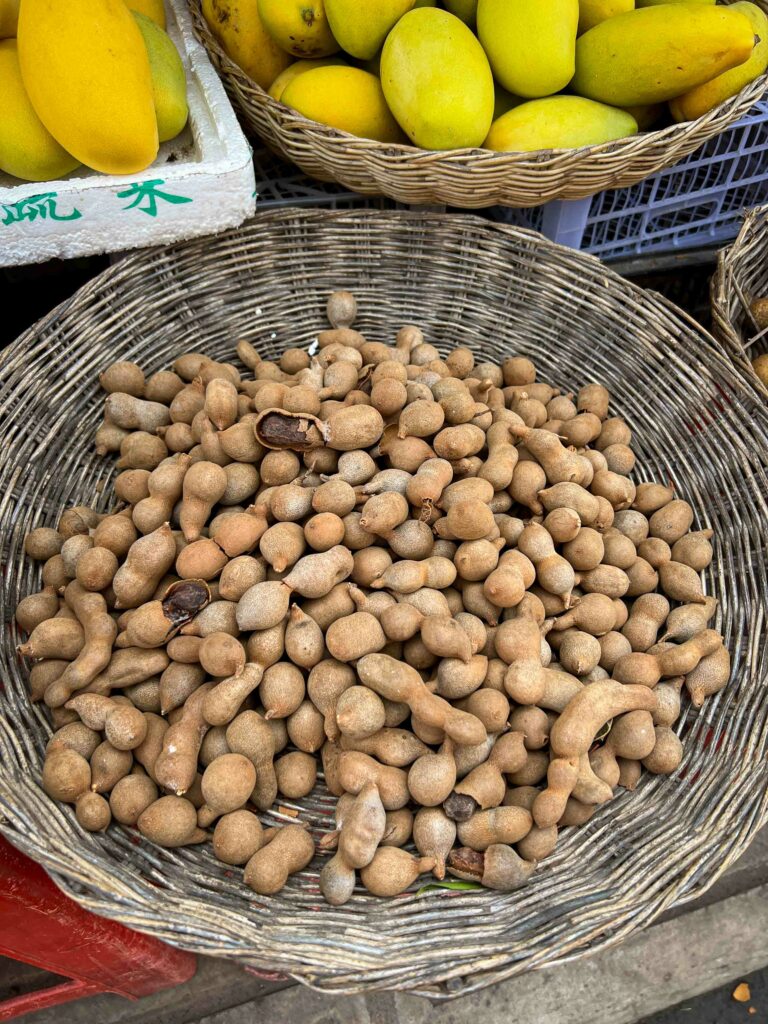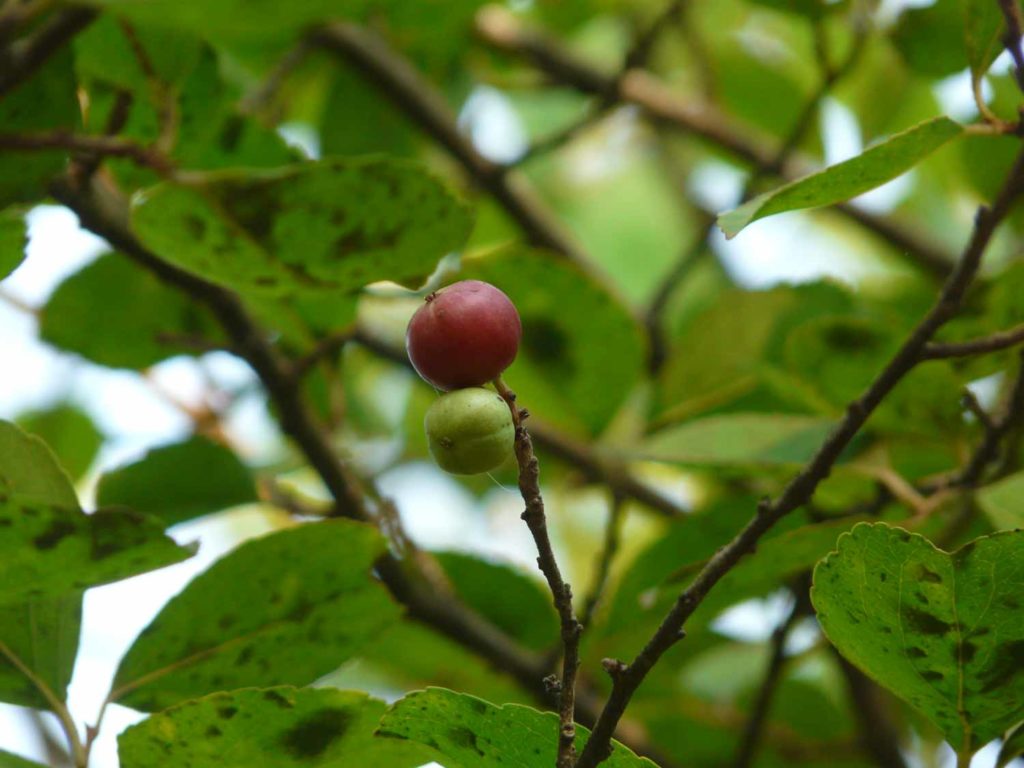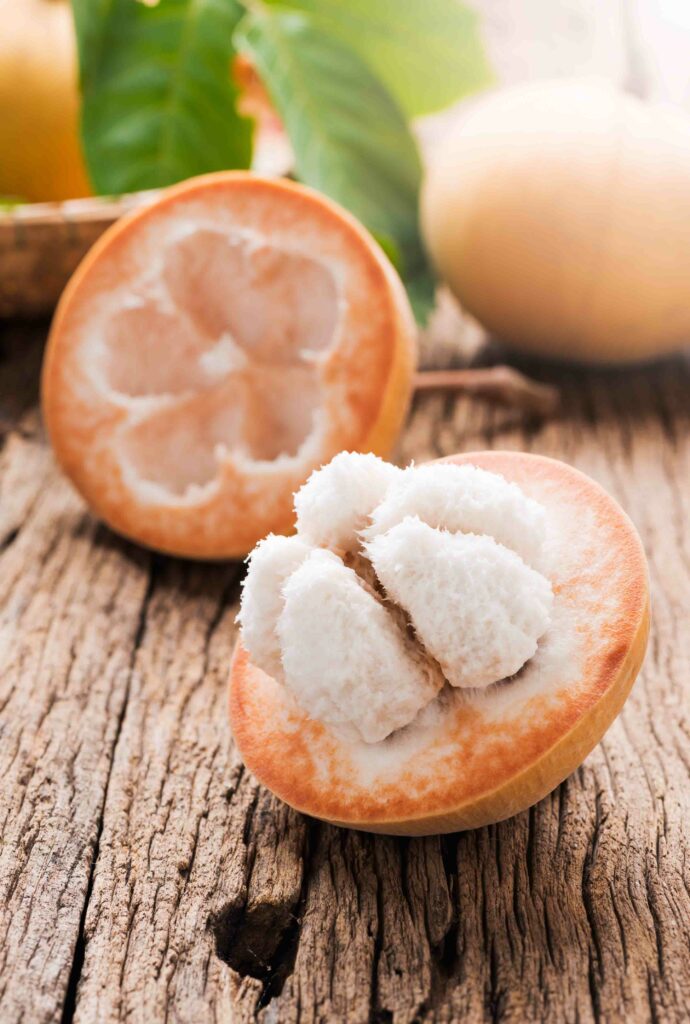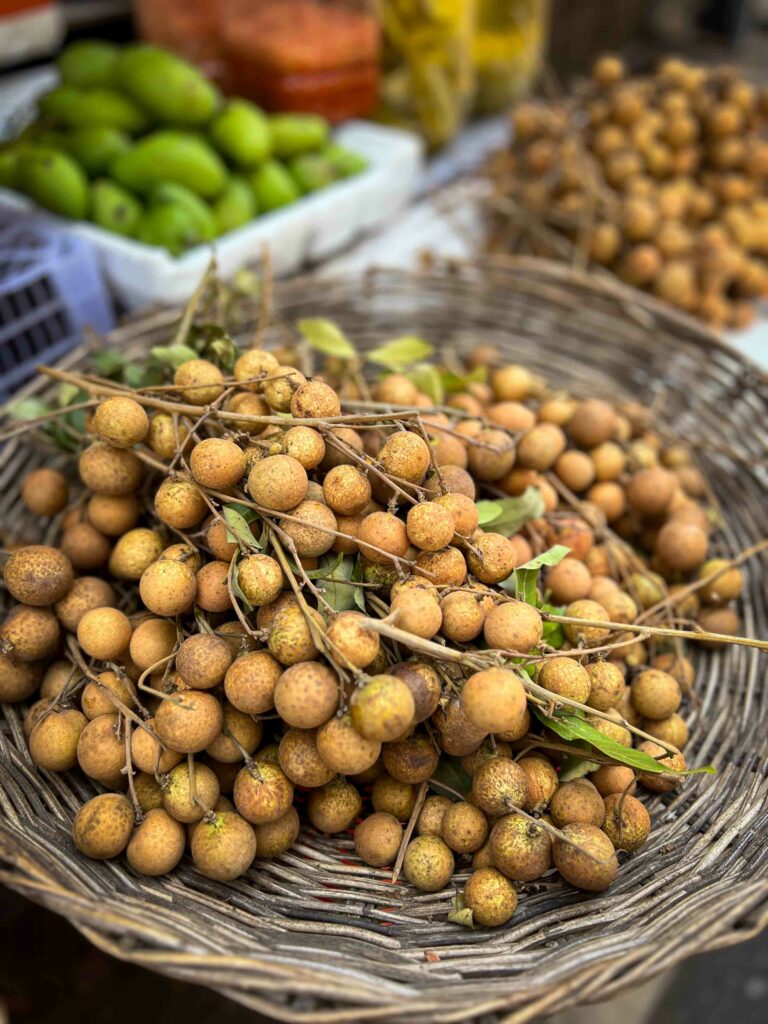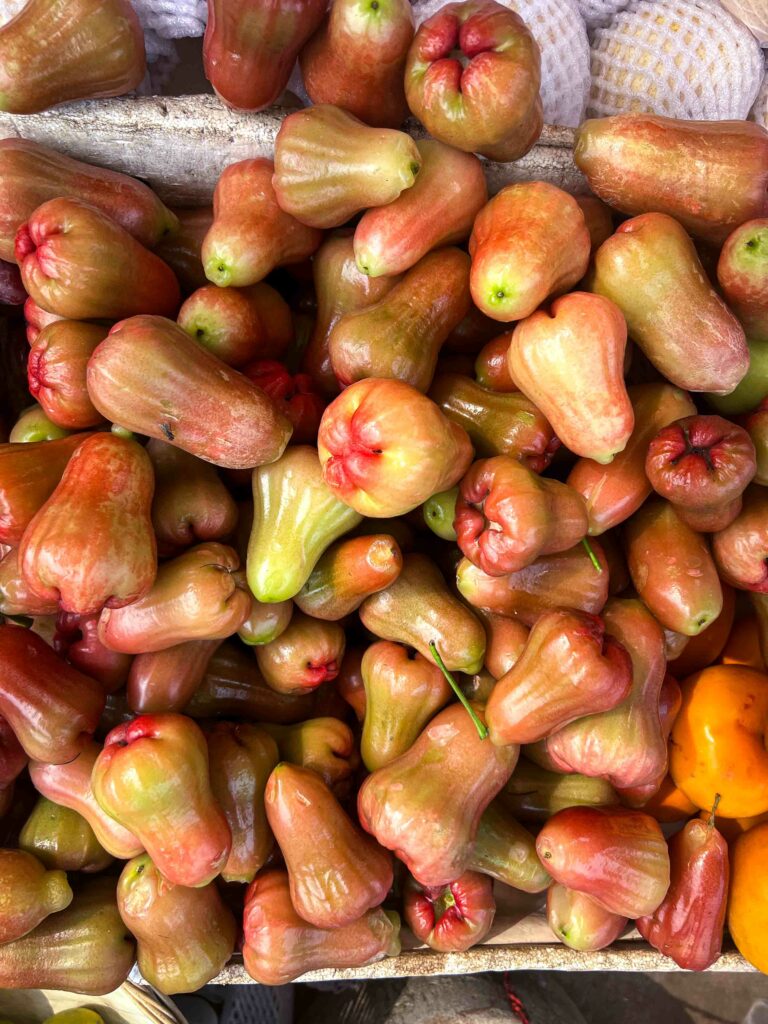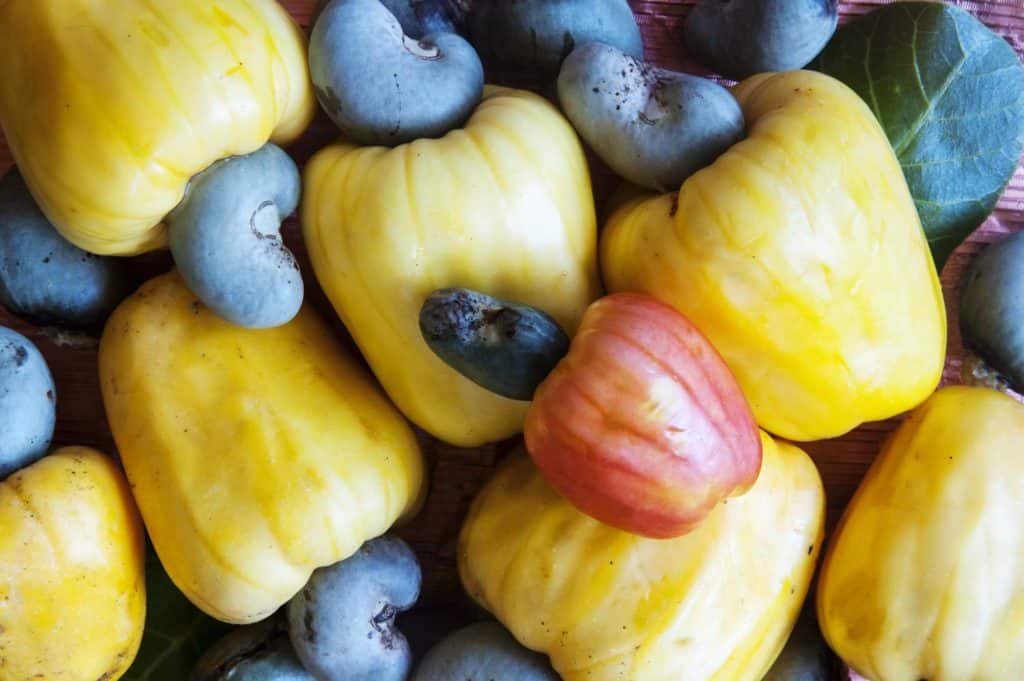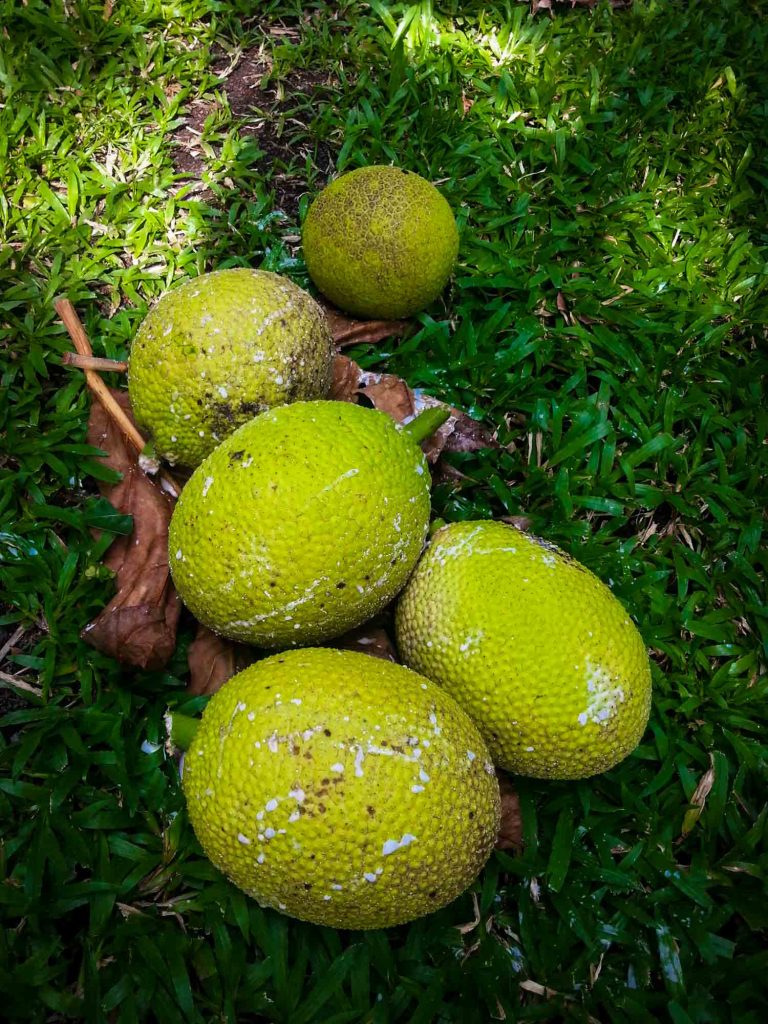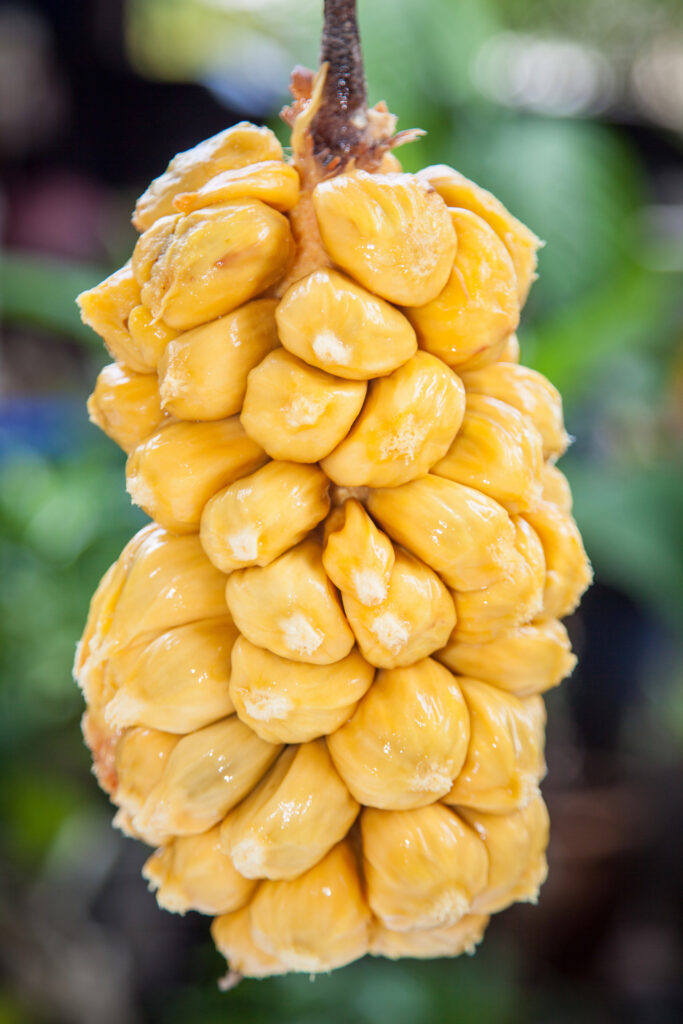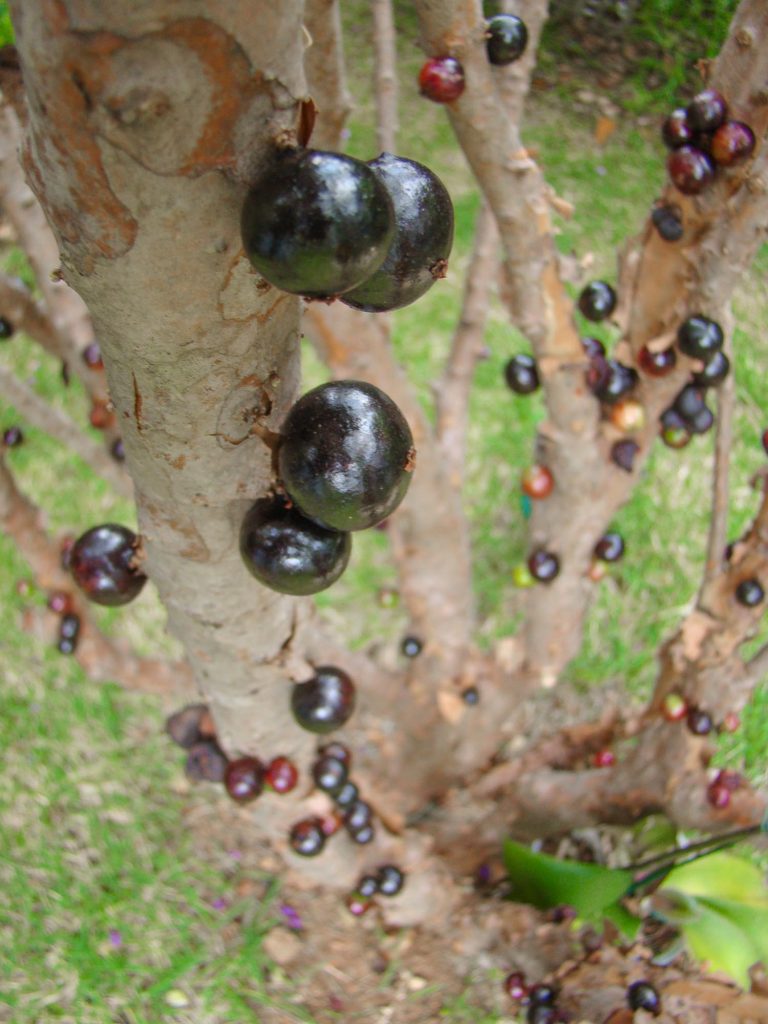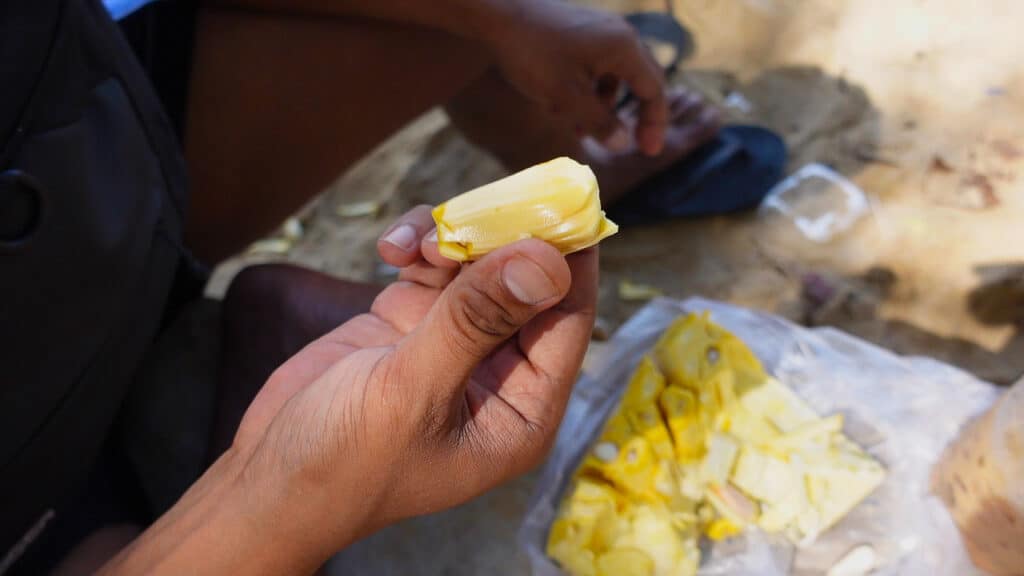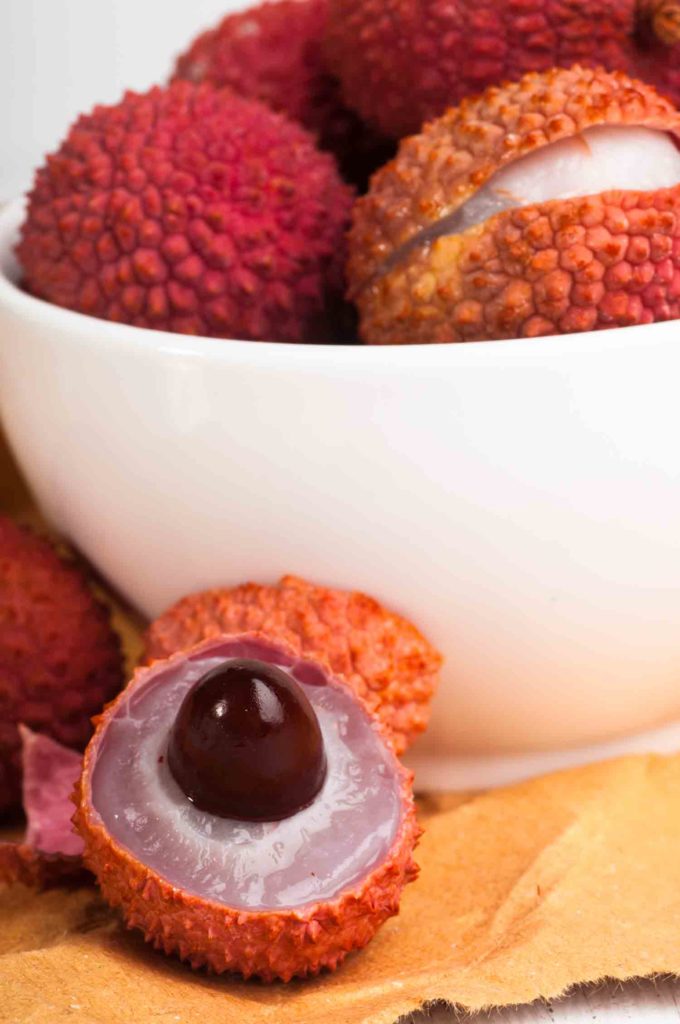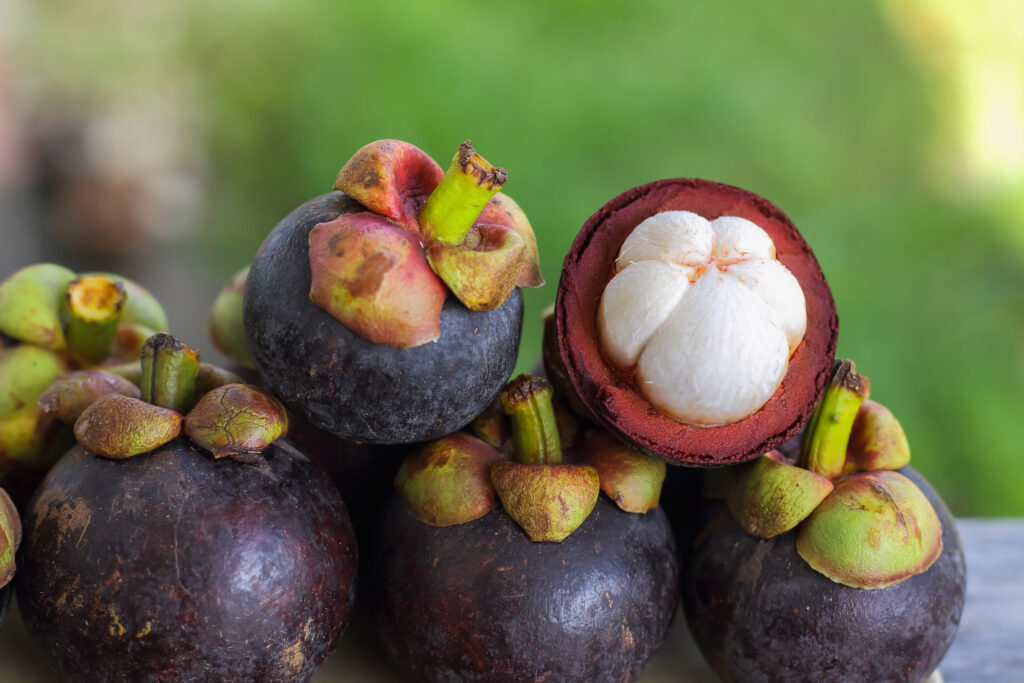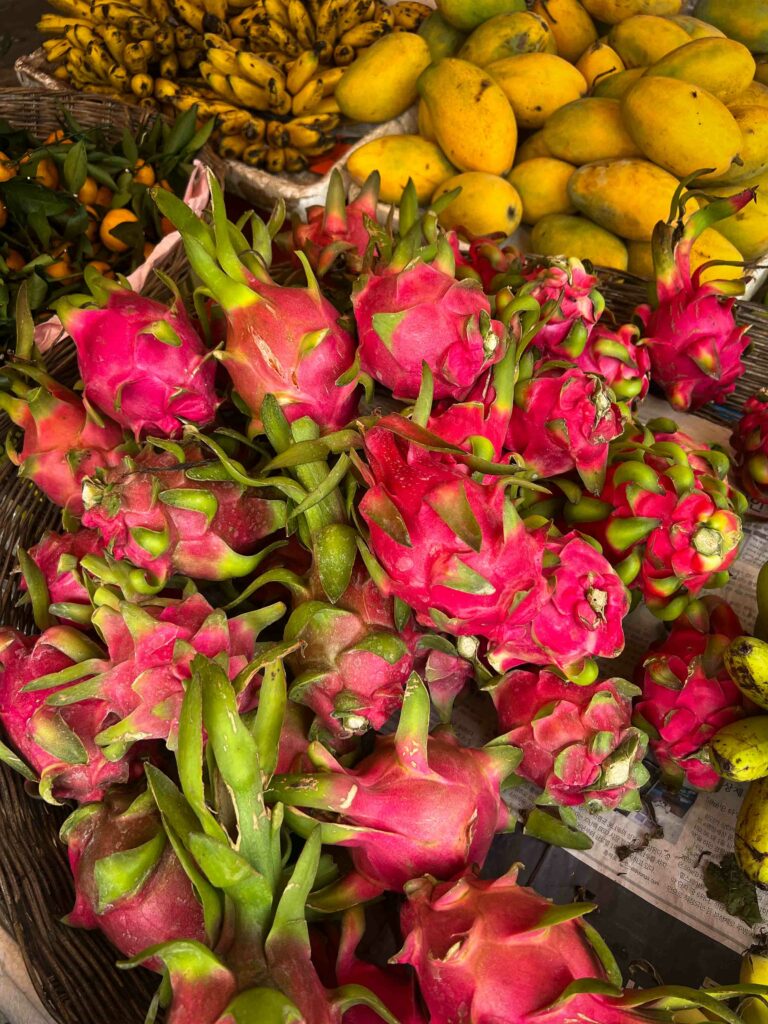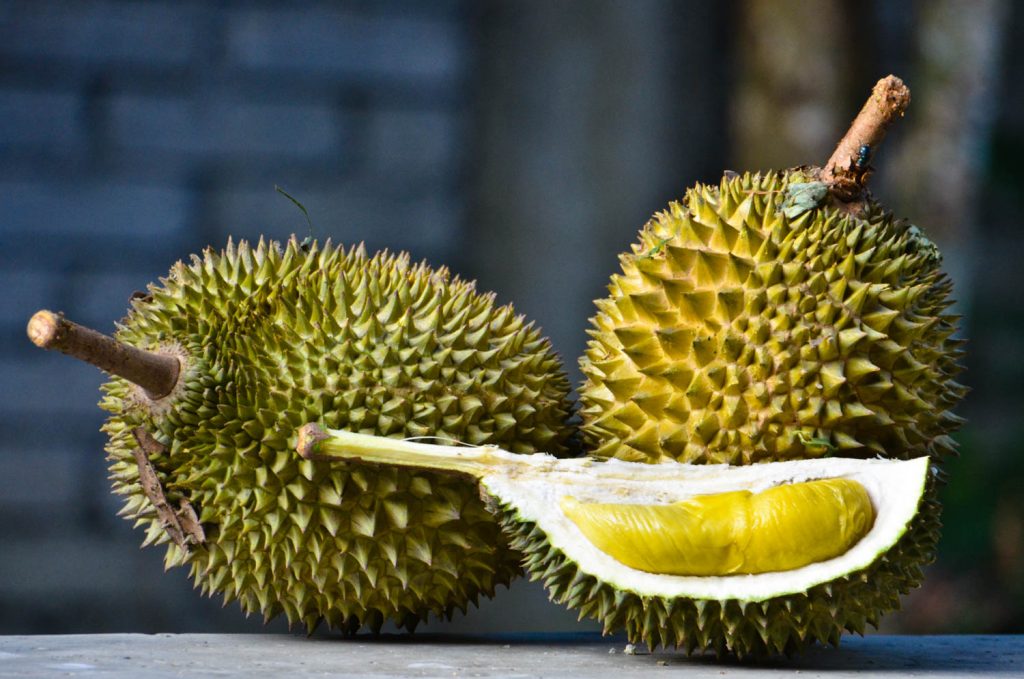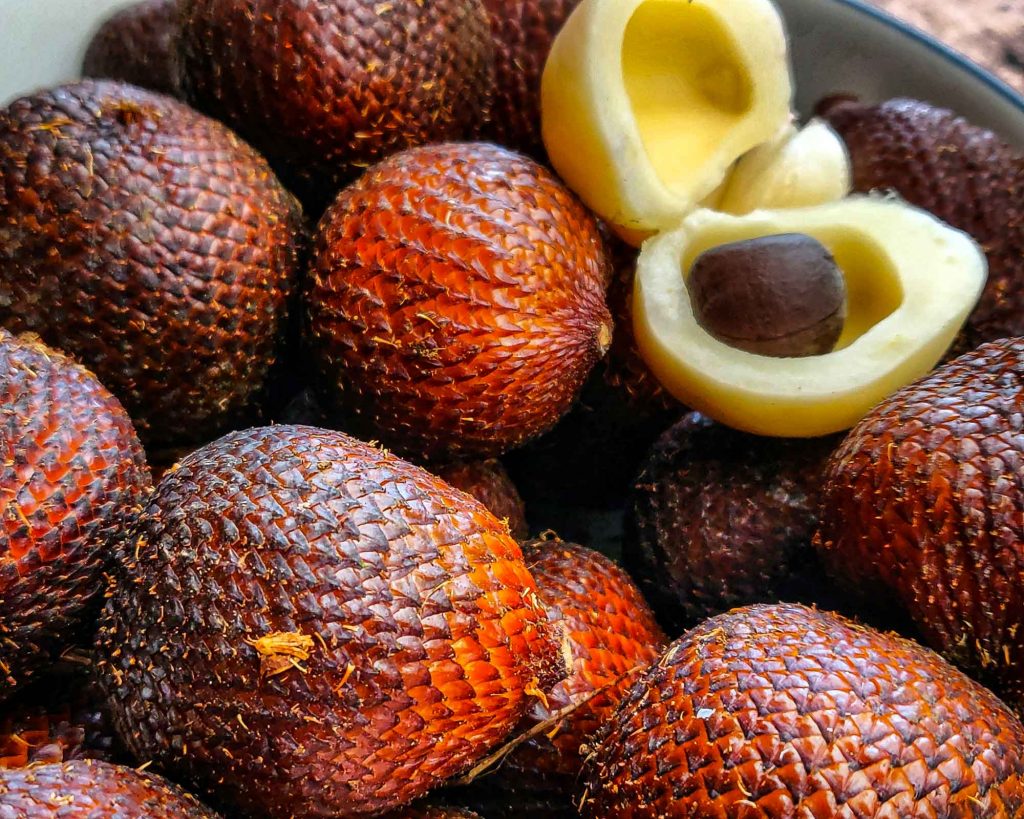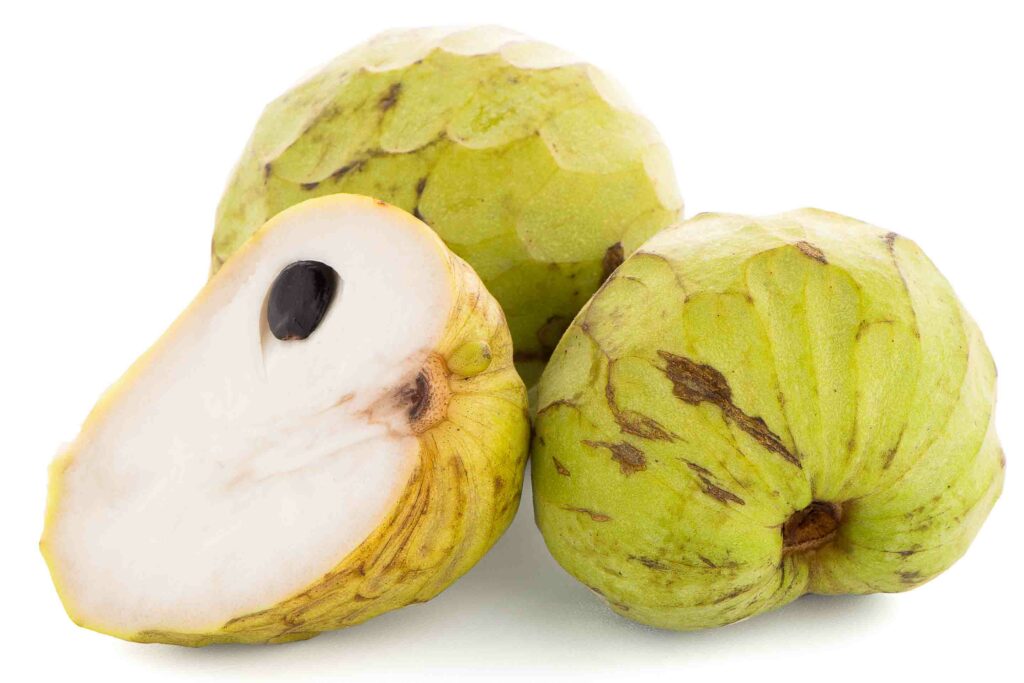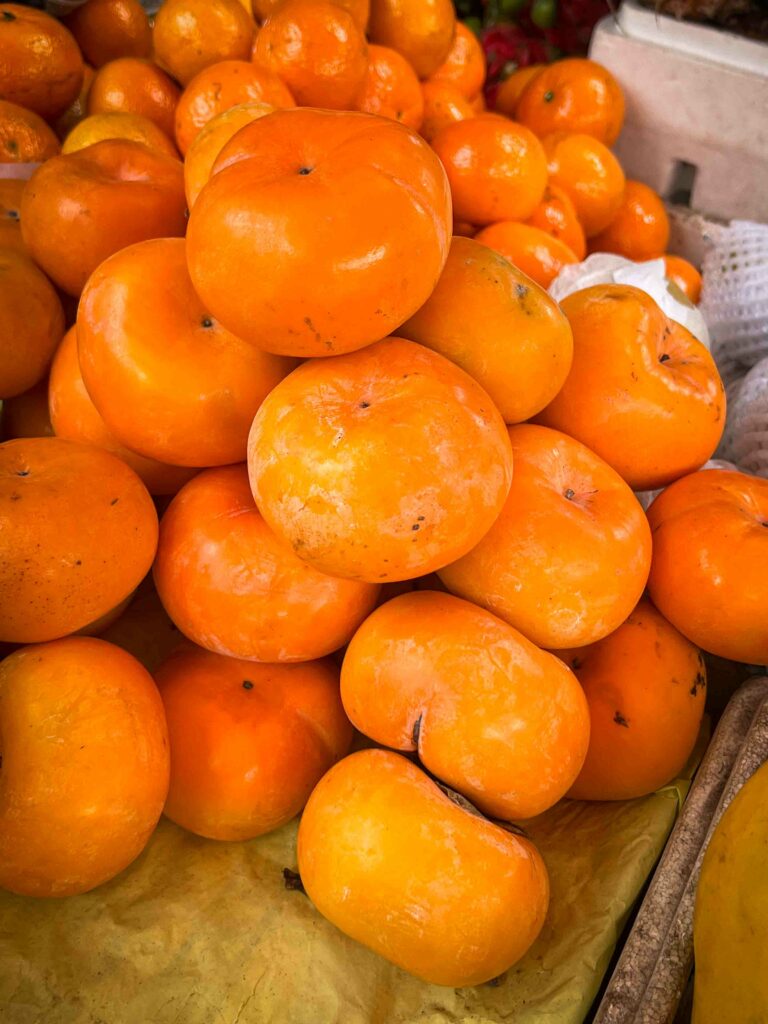These unusual fruits in Cambodia are worth buying a flight to the Land of the Khmers.
Many people visit Cambodia to pop into Angkor Wat, take some photos and move onto more popular Thailand or Vietnam.
But Cambodia has a rich history, vibrant culture and fantastic food that many sadly miss.
Cambodian fruit shares a fascinating story as it’s basically a mix of all the best exotic fruits around the world.
Although the country may be considered small today, the Khmer Empire once covered most of mainland Southeast Asia and into southern China.
It was larger than the Byzantine Empire and yet most westerners don’t know much about its history.
Many fruits were cultivated through the land and so popular Thai fruits or Malaysian fruits made its way to Cambodia.
It’s a mix of native fruits in Cambodia, those introduced along with those introduced by 16th century Portuguese merchants bringing European and South American fruits.
Royal Fruit Court
According to Wikipedia, Cambodian fruits are so loved that they actually have a royal court of fruits.
Of course durian is the king of fruits, mangosteen as the queen, sapodilla as the prince and milk fruit as the princess.
EXOTIC FRUITS IN CAMBODIA
Of course fruits in Cambodia include the typical oranges, mangos, papayas and grapefruit. But there are also more exotic fruits you may not have seen elsewhere.
Initially I was surprised at just how diverse Cambodian fruits could be, as some I had only seen before in Brazil. But I believe this is due to Portuguese merchants bringing these fruit to Cambodia.
Chicken Egg Banana | ចេកពងមាន់
Cambodia’s national fruit, in Khmer, the chicken egg banana is pronounced “chek pong moan.”
It’s a small, egg-sized banana variety known for its sweet taste. It’s a bit smaller than the Colombian fruit banana bocadillo or ladyfinger bananas.
The flesh is firm and creamy, often eaten raw or used in desserts. In Cambodia, it’s a favorite snack, especially when fully ripened to a yellow hue. But it’s also dried and preserved.
It grows along the Mekong River and is one of the most inexpensive Cambodian fruit.
Scientific Name: Musa aromatica
Chicken Egg Banana Season in Cambodia: All year round.
Madagascar Plum | ផ្លែកុង
Known as “pleah kong” in Khmer, the Madagascar plum is a small, red to purple fruit with a tangy and somewhat sweet flavor.
This Cambodia fruit is commonly eaten raw, with a sprinkle of salt or chili, or used in local jams.
Despite its name, the Madagascar Plum is native to parts of Asia and Africa.
Scientific Name: flacourtia indica
Common Names: batoka plum, bilangra, governor’s plum, Indian plum, tambat, ramontchi
Madagascar Plum Season in Cambodia: March to June
Burmese Grape | ផ្លែមេទ្រូង
The Burmese grape in Khmer is pronounced “play-ah may-trong.”
It’s a tropical fruit with a sweet and sour flavor, similar to a grape but larger and with a thicker skin. Cambodians enjoy it both raw and cooked.
The Burmese grape originates from the Southeast Asian region, including Myanmar and Thailand.
Scientific Name: baccaurea ramiflora
Common Names: kataphal, latka, mafai, tampoi
Burmese Grape Season in Cambodia: April to June
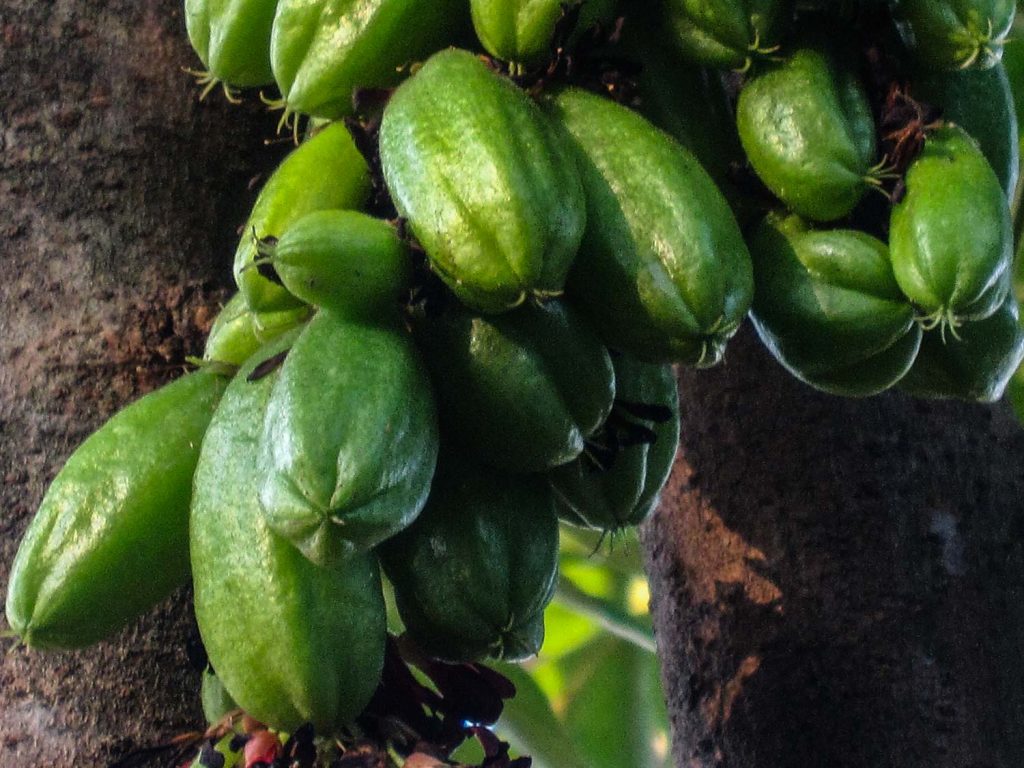
Bilimbi | ផ្លែទុំ
In Khmer, Bilimbi is pronounced “pleah tum.”
It’s a small, cucumber-shaped fruit with a sour taste, often used in cooking as a flavoring agent. It’s also eaten raw with salt and chili.
This Cambodian fruit is originally from Malaysia and Indonesia and is related to the star fruit tree. You can see as the ends of the blim blim almost have five sides.
And while it’s certainly an exotic fruit you can also find it in Guyana and the Caribbean as a popular Jamaican fruit called blim blim.
Scientific Name: averrhoa bilimbi
Common Names: bilimbi, blim blim, belimbing, belimbing buloh, cucumber tree
Bilimbi Season in Cambodia: Bilimbi is in season throughout the year in Cambodia.
Santol | សង្វាល
Santol, or “sangveal” in Khmer, is a round, yellow fruit. It has a thick, inedible rind and a juicy, tangy flesh cotton-like texture inside that surrounds the seeds.
Although not related, it is often called wild mangosteen as the shape of the fruit with is similar.
It has a unique sweet and sour taste. Cambodians consume it fresh or use it in savory dishes. It’s eaten fresh by sucking on the seeds or made into jams and candies.
The fruit is native to Southeast Asia and is one of the popular Filipino fruits you can find on the street.
Scientific Name: sandoricum koetjape
Common Names: kechapi, kecapi, kelampu, ketjape, ketuat, lolly fruit, ranggu, santol, sentul, sentol
Santol Season in Cambodia: June to August
Longan | លុងហ្គាន
Pronounced “Lung-gan” in Khmer, the longan is a small, round fruit with translucent flesh and a sweet, floral taste.
This Cambodia fruit is eaten fresh, often as a dessert or snack. This fruit is native to Southern Asia and one of the most common fruits in Vietnam sold on the streets.
Just make sure you don’t bite through as there is a bit in the middle.
Scientific Name: dimocarpus longan
Common Names: dragon’s eye, lungen, mata kuching
Longan Season in Cambodia: February to April
Java Cola | ផ្លែកុលា
The Java cola, or “pleah kola” in Khmer, has a taste that’s reminiscent of cola nuts.
It’s commonly used in traditional medicine and sometimes as a chewy snack.
It’s used in ayurveda and traditional Chinese medicine. So popular that the Lao fruit is the most common export after coffee.
Java cola is native to Southeast Asia, including Cambodia.
Scientific Name: sterculia lychnophora
Common Names: kembang semangkuk, malva nut tree, Taiwan sweet gum tree
Java Cola Season in Cambodia: The fruit is in season typically around the end of the rainy season.
Wax Apple | ផ្លែពោត
Known as “pleah pout” in Khmer, the Wax Apple has a bell shape with a crisp and watery texture.
Its taste is mildly sweet with a refreshing finish. Cambodians enjoy it as a snack or in fruit salads.
This Cambodia fruit is originally native to the Malay Peninsula and surrounding islands and is one of the common Bali fruits.
Scientific Name: syzygium samarangense
Common Names: chomphu-khieo, jambu air mawar, jambu klampok, jambu semarang, makopa
Wax Apple Season in Cambodia: The wax apple is generally available throughout the year.
Wood Apple | ផ្លែគ្រញូង
Wood apple, known as “pleah kronhuong” in Khmer, has a hard shell with a sticky, brown pulp that tastes sweet and tart.
It is often eaten with a spoon or made into a drink.
Wood Apple is native to the Indian subcontinent and is one of the most popular Sri Lankan fruits.
Scientific Name: limonia acidissima
Common Names: elephant apple
Wood Apple Season in Cambodia: March to May
Cashew | ផ្លែស្វាយចន្ទី
The cashew fruit, pronounced “pleah svay jan-tee” in Khmer, has a unique, sweet and tangy taste. Most people do not realize that cashew nuts are actually attached to fruit.
The cashew nut is attached to the bottom of the cashew apple, which is also edible and rich in vitamin C.
And while cashew fruits are edible, in other countries people don’t often eat them raw as they have an astringent flavor.
But in Cambodia you can find cashew fruit raw and sprinkled with salt to bring out the fruity, nutty flavors.
The cashew tree is native to northeastern Brazil.
Scientific Name: anacardium occidentale
Common Names: gandaria, gajus, jagus, janggus, jambu bongkok, jambu gajus, jambu golok, keterek, terek
Cashew Season in Cambodia: December to April.
Velvet Tamarind | ផ្លែអាម្ទិត
Velvet Tamarind is a small, velvety pod with a sweet and sour pulp inside.
It is pronounced “Pleah Am-teet” and is often eaten as a snack by sucking the flesh from the seeds.
Velvet Tamarind is indigenous to tropical Africa but has been cultivated in various parts of Southeast Asia.
The fruit is commonly found in the Cambodian countryside.
Scientific Name: dialium cochinchinense
Velvet Tamarind Season in Cambodia: During the dry months, typically from November to January.
Breadfruit | ផ្លែសណ្ដែក
Breadfruit, or “pleah sandek” in Khmer, has a starchy texture and a bland taste when raw, but when cooked, it develops a flavor similar to freshly baked bread.
It’s often used in savory dishes, fried or baked.
The fruit is native to the South Pacific and was spread throughout the tropics during the great Polynesian migrations.
It is now becoming a popular fruit in Hawaii and is known there as ulu. On Maui there is a Breadfruit Institute to study varieties and help bring them to regions that need sustainable food sources.
Scientific Name: artocarpus altilis
Common Names: kulur, kelor, sukun, suku, ulu
Breadfruit Season in Cambodia: Breadfruit is available throughout the year in Cambodia, with some seasonal variations.
Cempedak | ផ្លែចេនផាត
Cempedak is known as “pleah chen phat” in Khmer.
It is a close relative to jackfruit but with a softer texture and sweeter taste. It is commonly eaten fresh or fried in batter.
Cempedak is originally from Southeast Asia, it’s a popular Malaysian fruit and also common in Indonesia.
Scientific Name: artocarpus integer
Common Names: bangkong, baroh, champedah, chempedak, chempedak utan
Cempedak Season in Cambodia: June to August
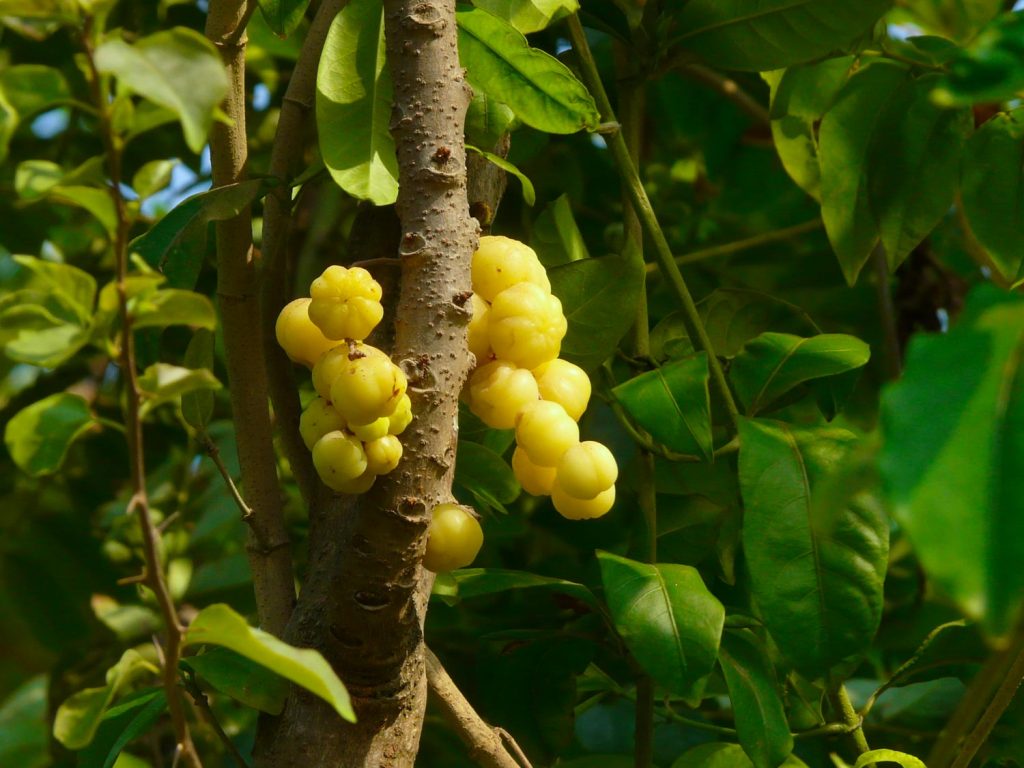
Gooseberry | ផ្លែរមៀត
In Khmer, Gooseberry is called “pleah romeat” and pronounced “Play-ah roh-meet.”
It’s a small, tart fruit often used in pickles, preserves, or eaten with salt and chili.
Gooseberry is native to Madagascar and was spread throughout the tropics, including Southeast Asia. In the Caribbean it’s more commonly known as Otaheite gooseberry.
Scientific Name: phyllanthus acidus
Common Names: Arbari. country gooseberry. grosella, Malay gooseberry, Otaheite gooseberry, star gooseberry, starberry, Tahitian gooseberry, West India gooseberry
Gooseberry Season in Cambodia: The fruit is available year-round, with some seasonal peaks.
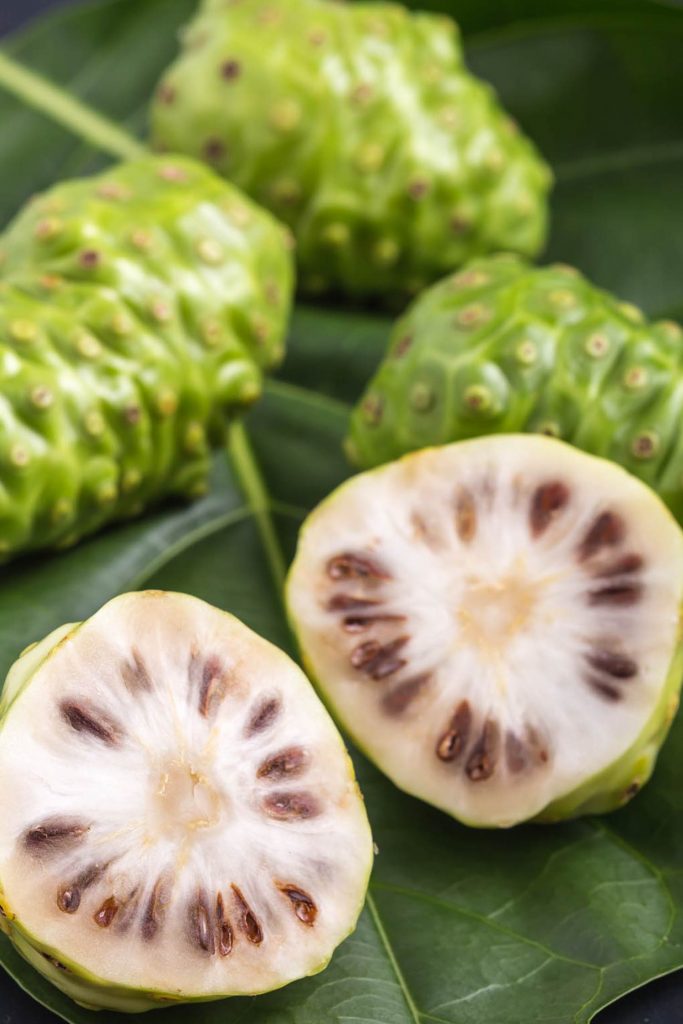
Noni | ផ្លែញី
Noni, pronounced “pleah nhee” in Khmer, is known for its strong, pungent aroma and bitter taste.
It’s often consumed as juice for its health benefits rather than for its flavor.
Universally the smell is considered more repulsive than durian. Noni has a strong, rotten cheese, vomit-like odor and it doesn’t taste much better.
However, equally it is considered amongst many cultures to be a miracle fruit that can cure just about anything, including life threatening diseases.
For this reason it’s often mixed with other juices to make it more palatable.
Noni is native to Southeast Asia and Australasia but you’ll also find it in South America where it’s one of many Ecuador fruits.
Scientific Name: morinda citrifolia
Common Names: awl tree, brimstone tree, cheese fruit, great morinda, inda, Indian mulberry, mengkudu besar
Noni Season in Cambodia: Throughout the year in Cambodia.
Carabao Teats | ផ្លែពពែក្រាប៉ោ
Carabao teats, pronounced “pleah po-pei krabao” in Khmer, is a fruit known for its peculiar shape resembling the teats of a water buffalo.
It has a sweet and tangy flavor, often compared to a combination of apple and grape. This fruit is typically eaten fresh or made into juices and jams.
The Carabao teats is native to Brazil but is now grown in various tropical climates, including Cambodia.
Scientific Name: plinia cauliflora
Common Names: Brazilian grape tree, jaboticaba, jabuticaba
Carabao Teats Season in Cambodia: March to May
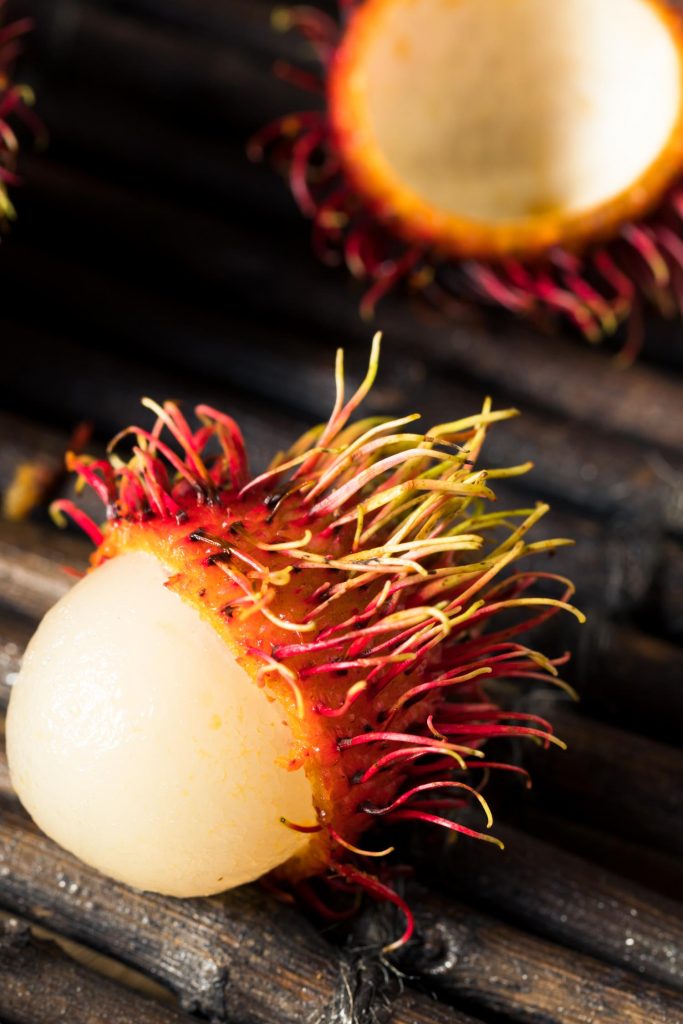
Rambutan | រំបូង
Pronounced “rum-bong” in Khmer, the rambutan is a hairy, red fruit with a juicy and sweet white center.
It tastes somewhat like a lychee, with a slightly acidic finish. Rambutan does not ripen once picked so when buying look for bright red, fresh looking fruit.
And don’t be shy to ask vendors not to give you the more dry, yellow looking fruit as it won’t be tasty.
To eat rambutan simply squeeze the fruit and it will break open, then pop the fruit in your mouth and suck the flesh off the skin.
Cambodians enjoy it fresh, often at room temperature. I love taking rambutan on long bus trips as it’s so refreshing.
And in Cambodia, it’s so beloved there’s a Rambutan Resort in Siem Reap!
This tropical delight hails from the Malay-Indonesian region and also thrives in warm climates.
It’s common in find in Latin America and is one of the most popular fruits in Panama.
Scientific Name: nephelium lappaceum
Rambutan Season in Cambodia: June to August
Jackfruit | ផ្លែខ្នុរ
In Khmer, jackfruit is called “pleah khnor.” It’s the largest fruit of the tree species, with a sweet, aromatic flavor.
Westerners may know this Cambodian fruit from a can as a vegan substitute for pulled pork. However, as a raw fruit it is one of the most delicious.
It tastes resembles a combination of apple, pineapple, mango and banana.
Cambodians eat it ripe as a fruit or unripe in curries. Jackfruit is believed to have originated in the Western Ghats of India.
However, you can find it throughout Latin America and the Caribbean where it is a popular fruit in Trinidad known as cowa.
Scientific Name: artocarpus heterophyllus
Common Names: jack, jak, jaka, jake tree, nangka, yaca
Jackfruit Season in Cambodia: December to February or March
Lychee | ផ្លែមៀន
Lychee, pronounced “pleah meen” in Khmer, is a fragrant fruit with a sweet and slightly tart flavor.
The outer skin is rough and red, while the inside is a translucent white flesh. It is typically eaten fresh, often savored for its juicy burst of flavor.
The fruit originally comes from the Fujian and Guangdong provinces in China but it common throughout South East Asia and is one of the most popular fruits in Laos.
Scientific Name: litchi chinensis
Common Names: litchee, lichi, litchi
Lychee season in Cambodia: May to June.
Mangosteen | ម៉ាន្តាន់
Mangosteen, or “mantean” in Khmer, is often called the “queen of fruits.”
It has a thick, purple rind with a sweet, tangy, and juicy interior. Mangosteen taste like a fruit cocktail mix of banana, strawberry and pear.
Many tourists are intimidated to buy them because they are not sure how to eat mangosteen as it has a tough leathery exterior.
Put the fruit between clasped hands and squeeze until the fruit cracks and the skin comes off easily to reveal the segments. Suck the flesh and spit out the seeds.
It’s typically eaten fresh, enjoyed for its succulent segments. It is a native Indonesian fruit from the Sunda Islands and the Moluccas.
Scientific Name: garcinia mangostana
Common Names: manggis, mangostino, mesetor, sementah, semetah
Mangosteen Season in Cambodia: May to October
Dragon fruit | ផ្លែនាងពពែ
Dragon fruit, or “pleah neang po poay” in Khmer, is a vibrant fruit with a mildly sweet taste and a kiwi-like texture.
It is typically eaten fresh, scooped right out of its spiky skin. In Cambodia, dragon fruit may have a white or pink interior.
Both have a pretty mild taste but look fantastic on a plate.
Dragon fruit is popular in smoothies and salads as well. This fruit is native to Central America and is a common Guatemalan fruit known as pitaya.
But has become a staple in Southeast Asian countries and you’ll find it everywhere.
Scientific Name: hylocereus undatus
Common Names: distelbirne, chacam, pitahaya
Dragon Fruit Season in Cambodia: June to November
Durian | ធូរ៉េន
Durian, pronounced “thou-ren” in Khmer, is known for its strong odor and distinctive taste, often described as a rich custard flavored with almonds.
Personally I think it depends on which one you try. The dark yellow tend to be fruitier and sweeter whereas the white are more slimey and funky.
I’ve tried durian several times and there are so many varieties if you hate it the first time keep trying. Just be aware of the durian burps as it’s much worse on the way back up!
Whether you love it or not, everyone agrees that it absolutely stinks. Throughout South East Asia you’ll find “no durian” signs in hotels and other public areas.
The Cambodian fruit is native to Borneo and Sumatra where it’s used in popular Padang food like es durian where it’s made into an ice cream.
Scientific Name: durio zibethinus
Durian Season in Cambodia: May to August
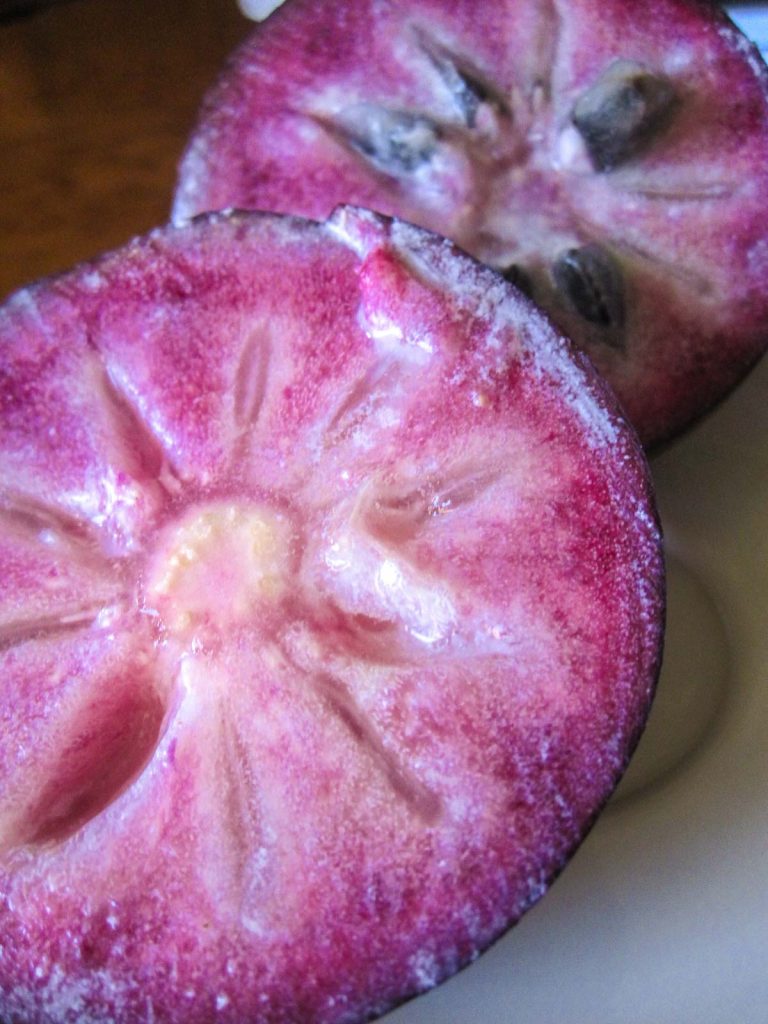
Milk Fruit | ផ្លែវ៉ា
Milk fruit or “pleah va” in Khmer, is a round fruit with a star-shaped pattern in the pulp when cut across.
It has a sweet, creamy taste that is often likened to a mix of apple and lychee.
Cambodians enjoy it chilled and cut in half, scooping out the flesh.
It is also known as star apple and is native to the Greater Antilles and the West Indies. You’ll also find it in Central America and is one of the popular fruits in Nicaragua.
Scientific Name: chrysophyllum cainito
Common Names: achras cainito, cainito, caimito
Star Apple Season in Cambodia: January to April
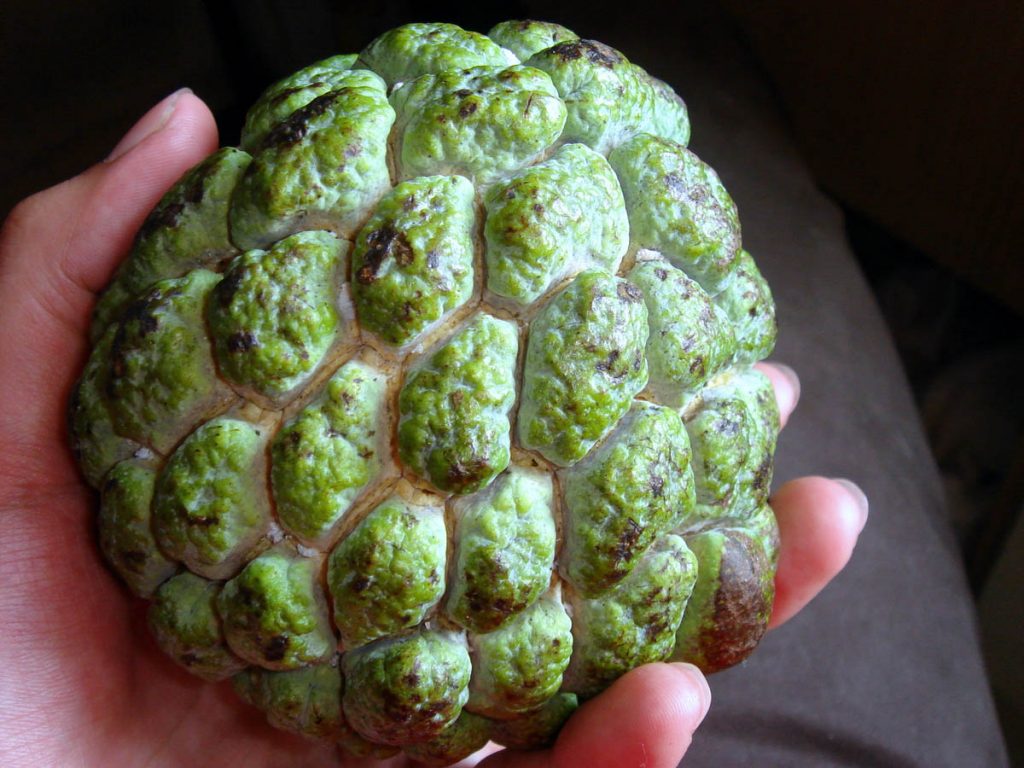
Sweet Sop | ផ្លែស្រកានាគ
Sweet sop, pronounced “pleah srak lanak” in Khmer, is also known as sugar apple.
It has a luscious, sweet flavor with a custard-like texture. It’s commonly eaten fresh, spooning out the flesh, and is a favorite among tropical fruits.
This fruit is thought to have originated in the tropical Americas, it is one of the best Cuban fruit to try.
Scientific Name: annona squamosa
Common Names: anona, buah nona, custard apple, nona, seri kaya, sugar apple
Sweet Sop Season in Cambodia: June to September
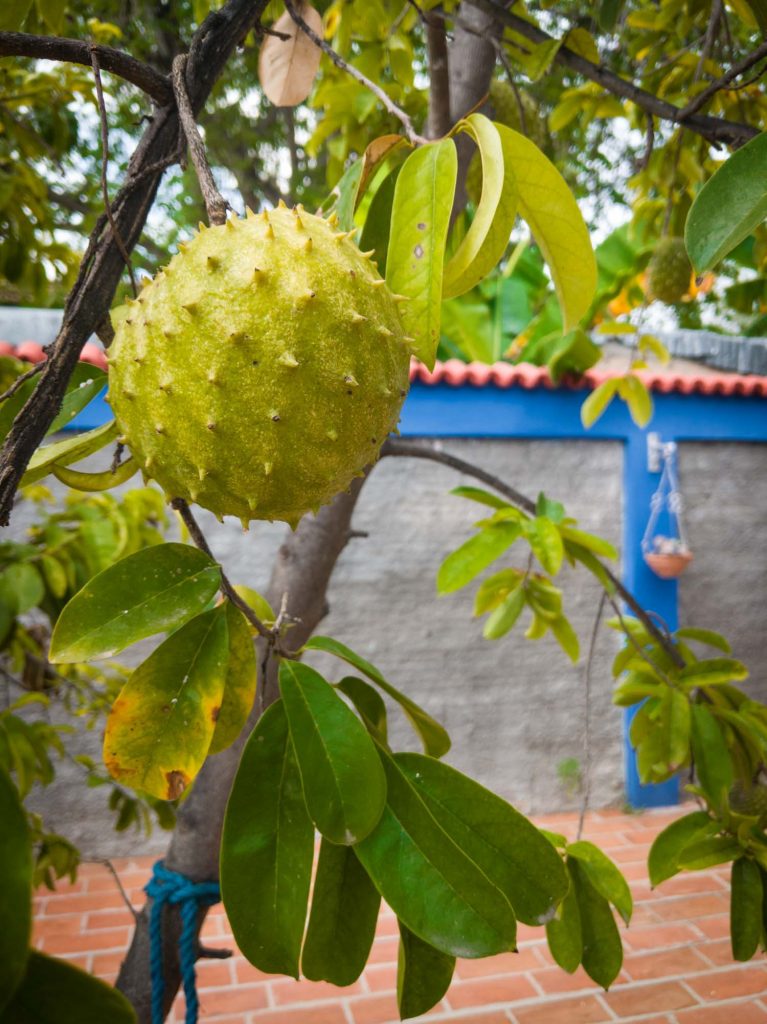
Soursop | ផ្លែទៀប
Soursop, known as “pleah teap” in Khmer and pronounced “play-ah teep.”
It has a tangy, sweet and sour taste with a soft, fibrous texture. It’s often used in smoothies, juices, or eaten as is.
Soursop is native to the Caribbean and Central America, where it’s a popular Costa Rican fruit. But also, it has become popular in many tropical regions, including Southeast Asia.
Scientific Name: annona muricata
Common Names: durian benggala, durian Belanda, durian makkah, guanabana, graviola, prickly custard apple
Soursop Season in Cambodia: April to November
Snakefruit | ផ្លែសាឡាក់
Salak, also known as snake fruit due to its reddish-brown scaly skin, is pronounced “pleah salaak” in Khmer.
This Cambodia fruit has a sweet and acidic taste with a crunchy texture. Salak is commonly eaten fresh, the flesh separated from the inedible seed inside.
Salak is native to Indonesia and is widely cultivated in Southeast Asia.
Scientific Name: salacca zalacca
Common Names: lizard-skinned fruit, salacca, snake palm, sala
Snakefruit Season in Cambodia: The fruit is typically available year-round, with some variations depending on the region.
Bullock’s Heart | ផ្លែប៊ូលឡក់ហាត់
Bullock’s heart is a large, heart-shaped fruit with a thick, creamy, and sweet flesh.
The fruit in Cambodia is commonly eaten fresh and is known for its custard-like texture.
Bullock’s heart is native to the West Indies, but it is also cultivated in other tropical regions.
Scientific Name: annona reticulata
Common Names: custard apple, sugar apple
Bullock’s Heart Season in Cambodia: February and May
Persimmon | ផ្លែពីស៊ីម៉ុន
Persimmon, or “Pleah Persimmon” in Khmer, is a sweet, slightly tangy fruit with a smooth, honey-like texture when fully ripe.
It can be eaten fresh, dried, or used in cooking and baking.
Persimmons are typically in season during the fall and winter months.
Scientific Name: diospyros kaki
Common Names: Chinese persimmon, Japanese persimmon, kaki persimmon, oriental persimmon
Persimmon Season in Cambodia: Persimmons are typically in season during the fall and winter months.
Black Sapote | ផ្លែប្លែកសាបូត
Black sapote is a tropical fruit that tastes like chocolate pudding when ripe.
It has a green skin that turns brown-black when ready to eat, and the flesh is rich and custard-like.
Black Sapote is a native Mexican fruit and also in Central America.
Scientific Name: diospyros digyna
Common Names: black soapapple, black persimmon, chocolate pudding fruit, zapote prieto
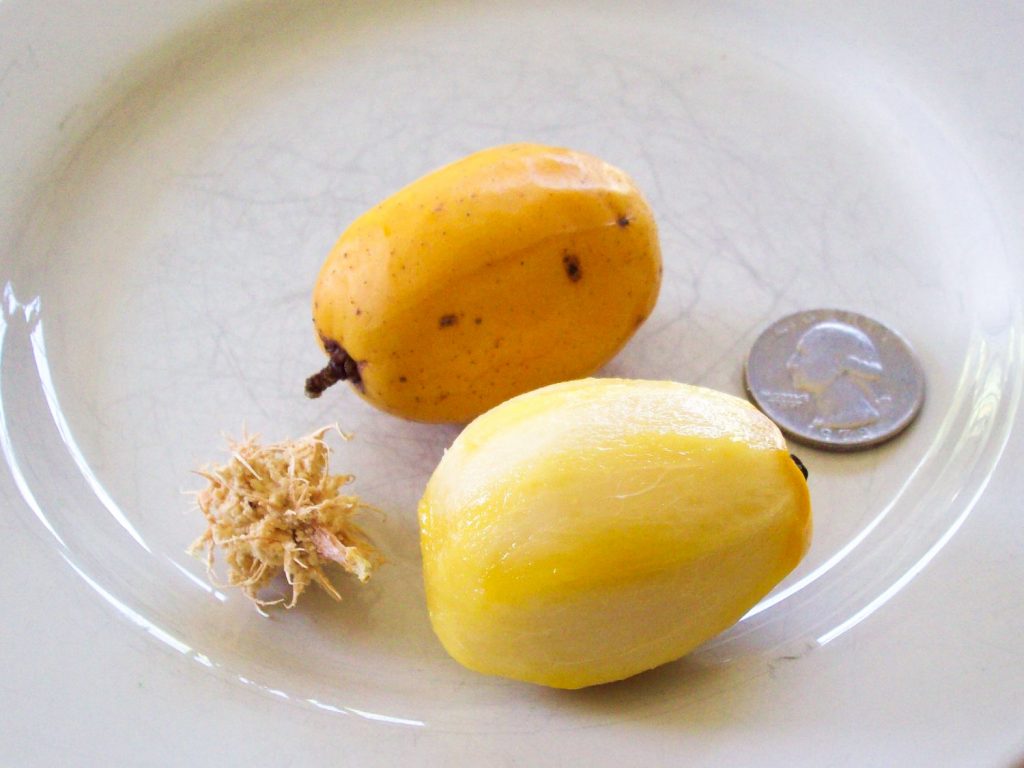
June Plum | ផ្លែជូនផ្លាំ
June plum is a tangy fruit that can be eaten raw when ripe or used unripe in a variety of dishes.
It is also known as ambarella and is commonly used in Southeast Asian cuisines. The fruit is native to Polynesia.
Scientific Name: spondias dulcis
Common Names: ambarella, great hog plum, golden apple, kedondong,Otaheite apple, yellow plum
June Plum Season in Cambodia: May to July
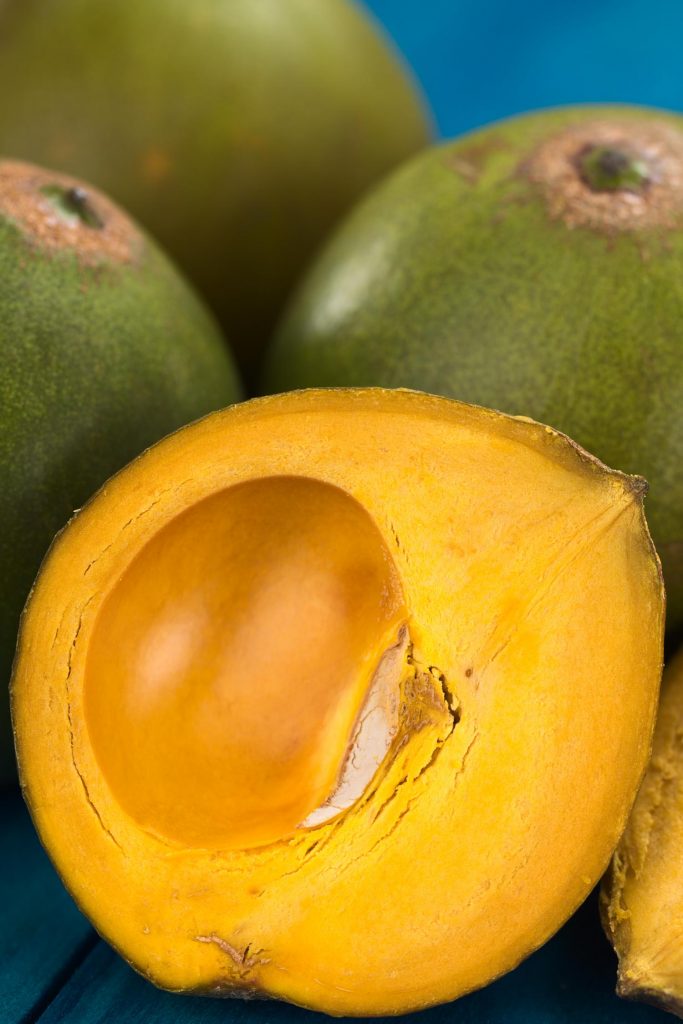
Egg Fruit | ផ្លែអេកហ្វ្រូត
Egg fruit is known for its sweet flavor and texture that resembles a hard-boiled egg yolk when ripe.
The flesh is rich and sweet, often used in smoothies, ice creams, and desserts. The fruit in Cambodia has color that ranges from yellow to orange.
It is native to southern Mexico, Central America and parts of South America where it’s commonly known as a Peru fruit.
Scientific Name: pouteria campechiana
Common Names: amarillo, canistel, sapote Borracho, yellow sapote, zapote
